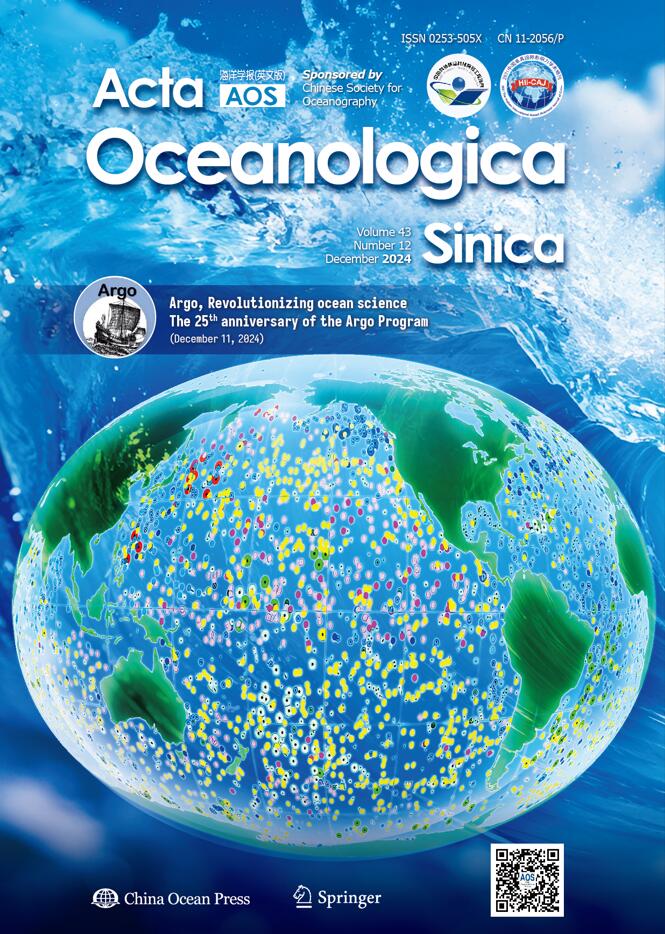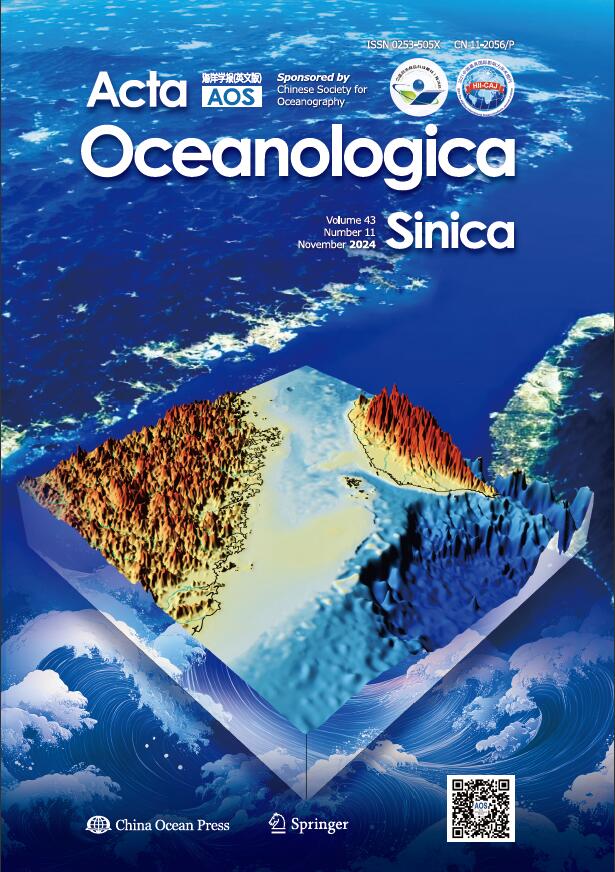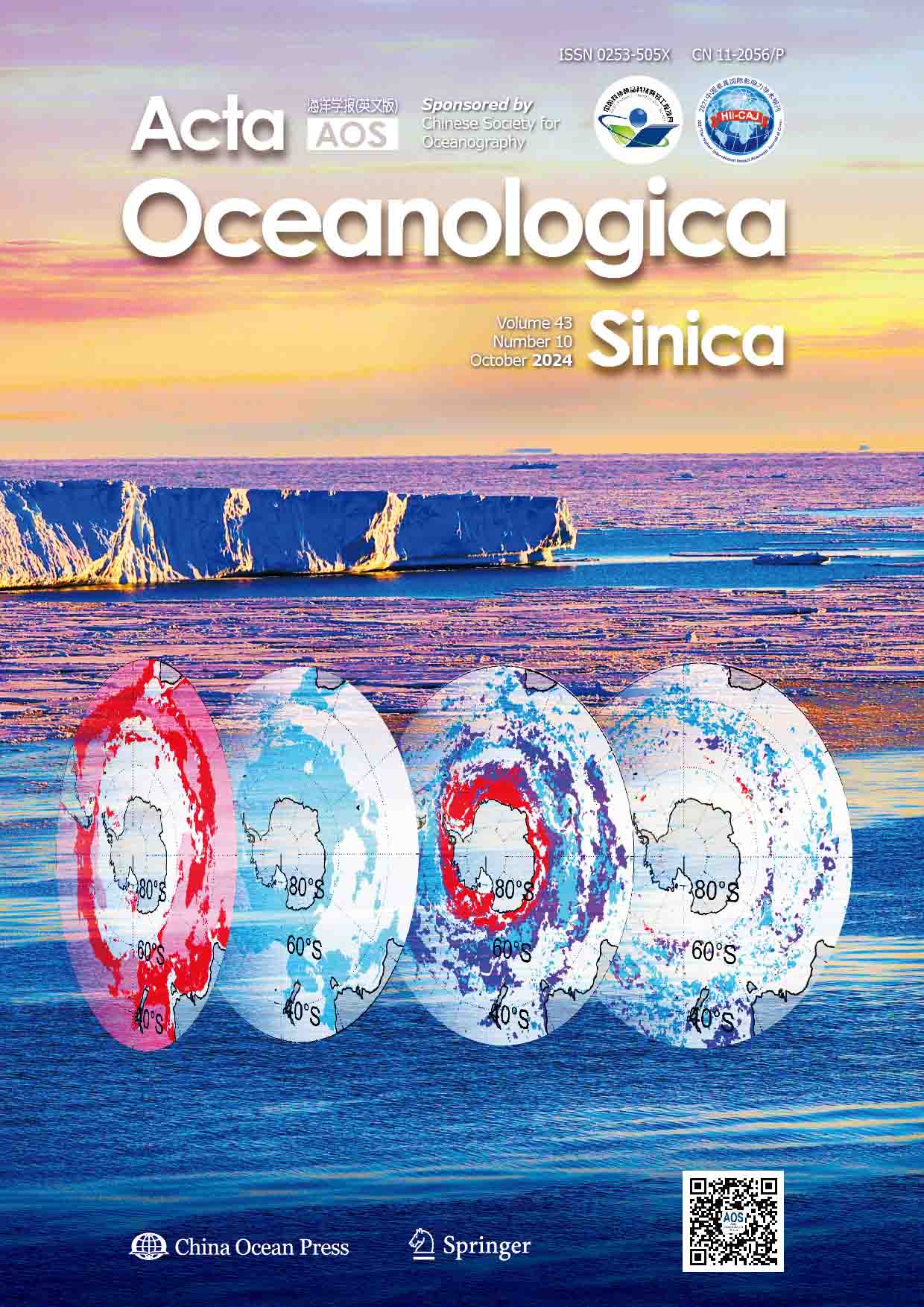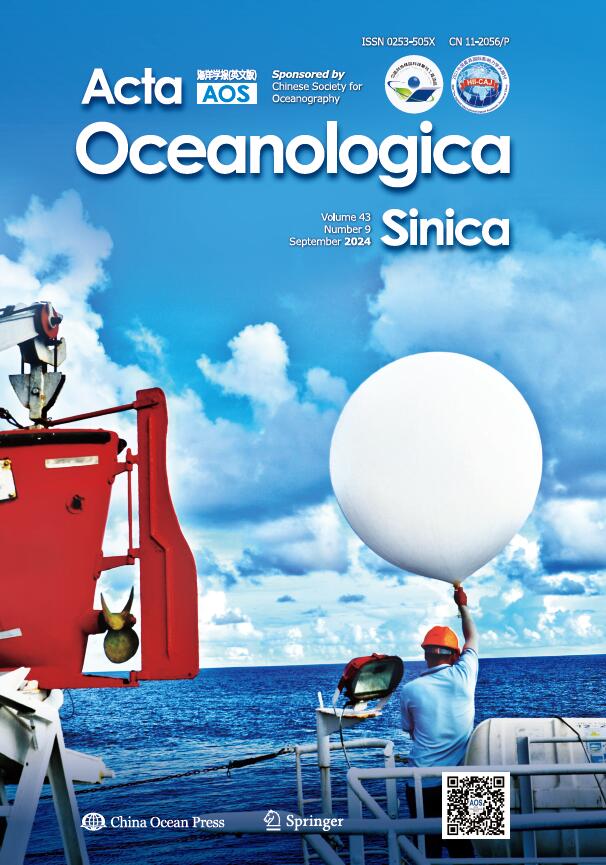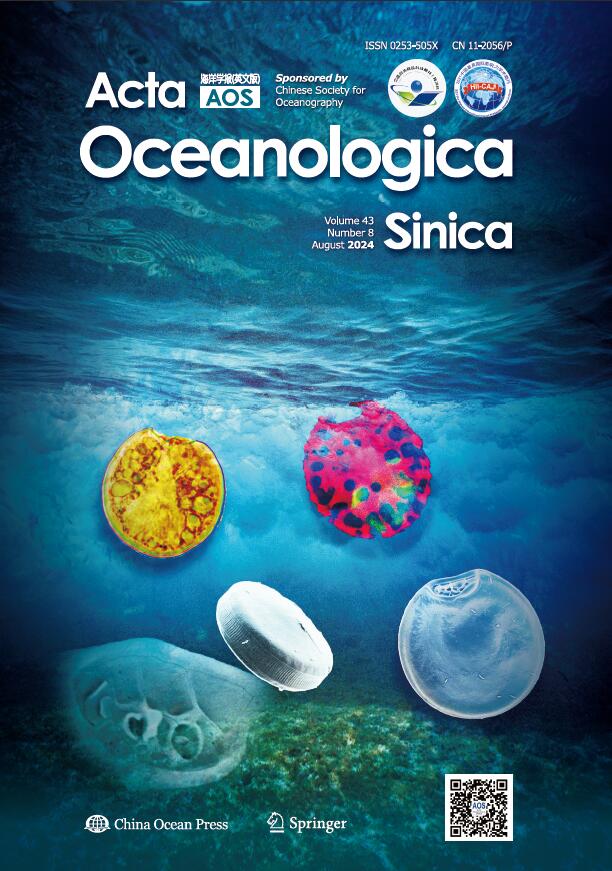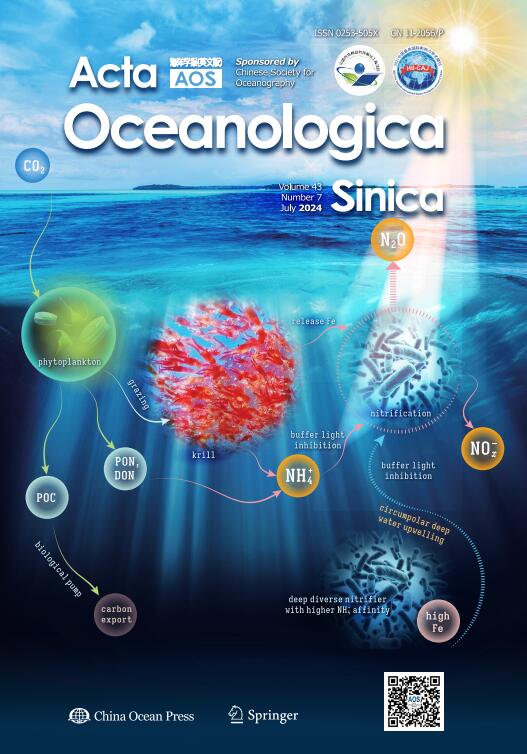2016 Vol. 35, No. 6
Display Method:
2016, 35(6): .
Abstract:
2016, 35(6): .
Abstract:
2016, 35(6): 1-6.
doi: 10.1007/s13131-016-0837-6
Abstract:
This study aims to quantify the effects of different pretreatment methods on the stable carbon isotope values of fatty acids in marine microalgae (Isochrysis zhanjiangenisis). To identify the effects of sample preparation on the δ13C value and the fatty acid composition, we examined eight types of pretreatment methods including: (a) drying the sample followed by direct methyl esterification using HCl-CH3OH; (b) drying the sample followed by direct methyl esterification using H2SO4-CH3OH; (c) drying the sample by ultrasonic extraction and methyl-esterification using HCl-CH3OH; (d) drying the sample by ultrasonic extraction and methyl-esterification using H2SO4-CH3OH; (e) fresh sample followed by direct methyl-esterification using HCl-CH3OH; (f) fresh sample followed by direct methyl-esterification using H2SO4-CH3OH; (g) fresh sample with ultrasonic extraction followed by methyl-esterification using HCl-CH3OH, and (h) fresh sample with ultrasonic extraction followed by methyl-esterification using H2SO4-CH3OH. The results show that the δ13C values from Groups a-e, g and h fluctuated within 0.3‰, and the δ13C values of Group f were approximately 0.7‰ lower than the other seven groups. Therefore, the different sample pretreatment methods used towards the extraction of fatty acids from marine microalgae may result in different results regarding the stable carbon isotope ratios, and if necessary a correction should be applied.
This study aims to quantify the effects of different pretreatment methods on the stable carbon isotope values of fatty acids in marine microalgae (Isochrysis zhanjiangenisis). To identify the effects of sample preparation on the δ13C value and the fatty acid composition, we examined eight types of pretreatment methods including: (a) drying the sample followed by direct methyl esterification using HCl-CH3OH; (b) drying the sample followed by direct methyl esterification using H2SO4-CH3OH; (c) drying the sample by ultrasonic extraction and methyl-esterification using HCl-CH3OH; (d) drying the sample by ultrasonic extraction and methyl-esterification using H2SO4-CH3OH; (e) fresh sample followed by direct methyl-esterification using HCl-CH3OH; (f) fresh sample followed by direct methyl-esterification using H2SO4-CH3OH; (g) fresh sample with ultrasonic extraction followed by methyl-esterification using HCl-CH3OH, and (h) fresh sample with ultrasonic extraction followed by methyl-esterification using H2SO4-CH3OH. The results show that the δ13C values from Groups a-e, g and h fluctuated within 0.3‰, and the δ13C values of Group f were approximately 0.7‰ lower than the other seven groups. Therefore, the different sample pretreatment methods used towards the extraction of fatty acids from marine microalgae may result in different results regarding the stable carbon isotope ratios, and if necessary a correction should be applied.
2016, 35(6): 7-11.
doi: 10.1007/s13131-016-0876-z
Abstract:
The genome size (C-value) of an organism is referring to the DNA content of its non-replicated haploid chromosome complement, generally deduced from measuring somatic diploid nuclei. We presented genome size (C-value) data obtained by flow cytometry for four commercially important crabs (Portunus trituberculatus, Charybdis japonica, Scylla paramamosain, and Eriocheir sinensis) common in the coast of China. Gallus domesticus (2C=2.5 pg) was used as the internal standard. The results showed that the C-value for P. trituberculatus, C. japonica, S. paramamosain, and E. sinensis were (2.31±0.01) pg, (2.33±0.03) pg, (1.64±0.02) pg, and (2.29±0.03) pg, respectively. The C-value of P. trituberculatus, C. japonica and S. paramamosain were reported for the first time. The data represented by the four species indicated that they had lower DNA contents than average DNA values in crustaceans ((4.99±0.48) pg), and three of the four values were very similar if not identical. The results provide useful data for future studies in the fields of biodiversity, species conservation, and phylogeny of these commercial crabs. They will also be helpful in instructing the hybridization breeding program and estimating the cost of the whole genome sequencing project.
The genome size (C-value) of an organism is referring to the DNA content of its non-replicated haploid chromosome complement, generally deduced from measuring somatic diploid nuclei. We presented genome size (C-value) data obtained by flow cytometry for four commercially important crabs (Portunus trituberculatus, Charybdis japonica, Scylla paramamosain, and Eriocheir sinensis) common in the coast of China. Gallus domesticus (2C=2.5 pg) was used as the internal standard. The results showed that the C-value for P. trituberculatus, C. japonica, S. paramamosain, and E. sinensis were (2.31±0.01) pg, (2.33±0.03) pg, (1.64±0.02) pg, and (2.29±0.03) pg, respectively. The C-value of P. trituberculatus, C. japonica and S. paramamosain were reported for the first time. The data represented by the four species indicated that they had lower DNA contents than average DNA values in crustaceans ((4.99±0.48) pg), and three of the four values were very similar if not identical. The results provide useful data for future studies in the fields of biodiversity, species conservation, and phylogeny of these commercial crabs. They will also be helpful in instructing the hybridization breeding program and estimating the cost of the whole genome sequencing project.
2016, 35(6): 12-18.
doi: 10.1007/s13131-016-0845-6
Abstract:
The inability of Fenneropenaeus chinensis to tolerate low temperatures is of major economic concern in temperate climates, as it reduces their growing season and leads to over-winter mortality. In this study, the heritability of body weight under low grow-out temperature and cold tolerance in F. chinensis were first investigated and estimated using 88 ful-sib families, which might provide crucial information in Chinese fleshy prawn breeding programs. The heritability for body weight under suitable and low temperature of F. chinensis were both moderate (0.158 0±0.307 5 and 0.132 0±0.026 9 respectively); the large coefficient of variation (approximately 21%) and moderate estimate of heritability for body weight indicated substantial potential for selective breeding. The heritability estimate for cold tolerance was low (0.019 2±0.023 5), and showed no significant differences from zero (P>0.05). A weak genetic correlation between cold tolerance and body weight was also estimated in the present study, also showing no significant differences from zero (P>0.05). Thus, more research needs to be conducted on the more accurate heritability estimate of cold tolerance and genetic correlations between traits in F. chinensis to further improve the achievement of breeding goals.
The inability of Fenneropenaeus chinensis to tolerate low temperatures is of major economic concern in temperate climates, as it reduces their growing season and leads to over-winter mortality. In this study, the heritability of body weight under low grow-out temperature and cold tolerance in F. chinensis were first investigated and estimated using 88 ful-sib families, which might provide crucial information in Chinese fleshy prawn breeding programs. The heritability for body weight under suitable and low temperature of F. chinensis were both moderate (0.158 0±0.307 5 and 0.132 0±0.026 9 respectively); the large coefficient of variation (approximately 21%) and moderate estimate of heritability for body weight indicated substantial potential for selective breeding. The heritability estimate for cold tolerance was low (0.019 2±0.023 5), and showed no significant differences from zero (P>0.05). A weak genetic correlation between cold tolerance and body weight was also estimated in the present study, also showing no significant differences from zero (P>0.05). Thus, more research needs to be conducted on the more accurate heritability estimate of cold tolerance and genetic correlations between traits in F. chinensis to further improve the achievement of breeding goals.
2016, 35(6): 19-28.
doi: 10.1007/s13131-016-0865-2
Abstract:
The signaling molecule hedgehog (Hh) is essential for cellular signaling required for body pattern formation in embryonic and individual development in vertebrate and invertebrates. Patched 1 (Ptc1), a receptor of Hh, mediates the activity of Hh by binging the Hh ligands. In this study, the Ptc1 of half-smooth tongue sole Cynoglossus semilaevis (CsPtc1) was cloned and characterized. The full-length of CsPtc1 cDNA is 5 212 nucleotides (nt), and encodes a protein with 1 543 amino acid residues. CsPtc1 shared many features with Ptc1 of other telesot species. Real-time quantitative PCR revealed CsPtc1 mRNA expressed in brain, liver, heart, gill, intestines, spleen, gonad and kidney, with expression level in testis significantly higher than in ovary. In testis, hybridization signals were mainly detected in primary spermatocytes, secondary spermatocytes, and sertoli cells, while weak signals were found in oocytes. Correspondingly, the degree of methylation is higher in female than in male and pseudo-male. Results indicate that CsPtc1 may be involved in Desert Hedgehog (DHH) maintenance of the male and pseudo-male germ line and spermatogenesis.
The signaling molecule hedgehog (Hh) is essential for cellular signaling required for body pattern formation in embryonic and individual development in vertebrate and invertebrates. Patched 1 (Ptc1), a receptor of Hh, mediates the activity of Hh by binging the Hh ligands. In this study, the Ptc1 of half-smooth tongue sole Cynoglossus semilaevis (CsPtc1) was cloned and characterized. The full-length of CsPtc1 cDNA is 5 212 nucleotides (nt), and encodes a protein with 1 543 amino acid residues. CsPtc1 shared many features with Ptc1 of other telesot species. Real-time quantitative PCR revealed CsPtc1 mRNA expressed in brain, liver, heart, gill, intestines, spleen, gonad and kidney, with expression level in testis significantly higher than in ovary. In testis, hybridization signals were mainly detected in primary spermatocytes, secondary spermatocytes, and sertoli cells, while weak signals were found in oocytes. Correspondingly, the degree of methylation is higher in female than in male and pseudo-male. Results indicate that CsPtc1 may be involved in Desert Hedgehog (DHH) maintenance of the male and pseudo-male germ line and spermatogenesis.
2016, 35(6): 29-33.
doi: 10.1007/s13131-016-0868-z
Abstract:
Oxygen and carbon isotope ratios (δ18O and δ13C) in otoliths were used to identify the stock structure of small yellow croaker, Larimichthys polyactis. Otoliths were collected from fish at five locations across the Yellow Sea and the Bohai Sea representing most of their distributional range and fisheries areas. The significant differences in the isotopic signatures showed that the five locations could be chemically distinguished and clearly separated, indicating stock subdivision. Correlation of δ18O and δ13C values suggested that population of L. polyactis could be divided into the Bohai Sea group, the southern Yellow Sea group and the central Yellow Sea group. Discriminant analysis of δ18O and δ13C values demonstrated a high significant difference with 85.7% classification accuracy. The spatial separation of L. polyactis indicated a complex stock structure across the Yellow Sea and the Bohai Sea. These results indicate that optimal fisheries management may require a comprehensive consideration on the current spatial arrangements. This study has provided further evidence that measurement of the stable isotopes ratios in otolith can be a valuable tool in the delineation of fishery management units.
Oxygen and carbon isotope ratios (δ18O and δ13C) in otoliths were used to identify the stock structure of small yellow croaker, Larimichthys polyactis. Otoliths were collected from fish at five locations across the Yellow Sea and the Bohai Sea representing most of their distributional range and fisheries areas. The significant differences in the isotopic signatures showed that the five locations could be chemically distinguished and clearly separated, indicating stock subdivision. Correlation of δ18O and δ13C values suggested that population of L. polyactis could be divided into the Bohai Sea group, the southern Yellow Sea group and the central Yellow Sea group. Discriminant analysis of δ18O and δ13C values demonstrated a high significant difference with 85.7% classification accuracy. The spatial separation of L. polyactis indicated a complex stock structure across the Yellow Sea and the Bohai Sea. These results indicate that optimal fisheries management may require a comprehensive consideration on the current spatial arrangements. This study has provided further evidence that measurement of the stable isotopes ratios in otolith can be a valuable tool in the delineation of fishery management units.
2016, 35(6): 34-41.
doi: 10.1007/s13131-016-0844-7
Abstract:
Monthly fishery survey data of the small yellow croaker Larimichthys polyactis in the southern Yellow Sea from 2003 and 2013 were employed to evaluate the variation in the resource distribution and biological characteristics (especially body length and sex ratio) in the population on a decadal scale. The results indicated that the small yellow croaker migrated from the Shawai fishing ground to the Dasha fishing ground in spring and was mainly distributed in the central and western parts of the Dasha fishing ground in April and May. Larimichthys polyactis in the Dasha fishing ground migrated eastward to offshore wintering grounds in autumn and reached the central Dasha fishing ground in October and November. The small yellow croaker entered the western waters of the Shawai fishing ground in winter. A large number of age 0+ fish occurred in the Shawai and Jiangwai fishing grounds in October of 2003 and 2013. The body lengths of the spawning stock and wintering stock in 2013 were larger than those in 2003, and the monthly sex ratios (female to male) were significantly less than 1 in both years. The monthly distribution of this fish in the southern Yellow Sea was consistent with a previous finding that "the stock migrated between the wintering grounds in the west of Jeju Island and the Lüsi spawning grounds" but tended to move more northward, with the spawning grounds extending outward. In the past decade, body length variation experienced a decline after an increase, rather than a steady decrease. The sex ratio in the single-stick stow net showed a tendency to increase over the decade, but was either less than or more than 1 depending on the fishing gear; therefore, further studies should be conducted to determine the sex structure.
Monthly fishery survey data of the small yellow croaker Larimichthys polyactis in the southern Yellow Sea from 2003 and 2013 were employed to evaluate the variation in the resource distribution and biological characteristics (especially body length and sex ratio) in the population on a decadal scale. The results indicated that the small yellow croaker migrated from the Shawai fishing ground to the Dasha fishing ground in spring and was mainly distributed in the central and western parts of the Dasha fishing ground in April and May. Larimichthys polyactis in the Dasha fishing ground migrated eastward to offshore wintering grounds in autumn and reached the central Dasha fishing ground in October and November. The small yellow croaker entered the western waters of the Shawai fishing ground in winter. A large number of age 0+ fish occurred in the Shawai and Jiangwai fishing grounds in October of 2003 and 2013. The body lengths of the spawning stock and wintering stock in 2013 were larger than those in 2003, and the monthly sex ratios (female to male) were significantly less than 1 in both years. The monthly distribution of this fish in the southern Yellow Sea was consistent with a previous finding that "the stock migrated between the wintering grounds in the west of Jeju Island and the Lüsi spawning grounds" but tended to move more northward, with the spawning grounds extending outward. In the past decade, body length variation experienced a decline after an increase, rather than a steady decrease. The sex ratio in the single-stick stow net showed a tendency to increase over the decade, but was either less than or more than 1 depending on the fishing gear; therefore, further studies should be conducted to determine the sex structure.
2016, 35(6): 42-49.
doi: 10.1007/s13131-016-0875-0
Abstract:
The precise and accurate knowledge of genetic parameters is a prerequisite for making efficient selection strategies in breeding programs. A number of estimators of heritability about important economic traits in many marine mollusks are available in the literature, however very few research have evaluated about the accuracy of genetic parameters estimated with different family structures. Thus, in the present study, the effect of parent sample size for estimating the precision of genetic parameters of four growth traits in clam M. meretrix by factorial designs were analyzed through restricted maximum likelihood (REML) and Bayesian. The results showed that the average estimated heritabilities of growth traits obtained from REML were 0.23-0.32 for 9 and 16 full-sib families and 0.19-0.22 for 25 full-sib families. When using Bayesian inference, the average estimated heritabilities were 0.11-0.12 for 9 and 16 full-sib families and 0.13-0.16 for 25 full-sib families. Compared with REML, Bayesian got lower heritabilities, but still remained at a medium level. When the number of parents increased from 6 to 10, the estimated heritabilities were more closed to 0.20 in REML and 0.12 in Bayesian inference. Genetic correlations among traits were positive and high and had no significant difference between different sizes of designs. The accuracies of estimated breeding values from the 9 and 16 families were less precise than those from 25 families. Our results provide a basic genetic evaluation for growth traits and should be useful for the design and operation of a practical selective breeding program in the clam M. meretrix.
The precise and accurate knowledge of genetic parameters is a prerequisite for making efficient selection strategies in breeding programs. A number of estimators of heritability about important economic traits in many marine mollusks are available in the literature, however very few research have evaluated about the accuracy of genetic parameters estimated with different family structures. Thus, in the present study, the effect of parent sample size for estimating the precision of genetic parameters of four growth traits in clam M. meretrix by factorial designs were analyzed through restricted maximum likelihood (REML) and Bayesian. The results showed that the average estimated heritabilities of growth traits obtained from REML were 0.23-0.32 for 9 and 16 full-sib families and 0.19-0.22 for 25 full-sib families. When using Bayesian inference, the average estimated heritabilities were 0.11-0.12 for 9 and 16 full-sib families and 0.13-0.16 for 25 full-sib families. Compared with REML, Bayesian got lower heritabilities, but still remained at a medium level. When the number of parents increased from 6 to 10, the estimated heritabilities were more closed to 0.20 in REML and 0.12 in Bayesian inference. Genetic correlations among traits were positive and high and had no significant difference between different sizes of designs. The accuracies of estimated breeding values from the 9 and 16 families were less precise than those from 25 families. Our results provide a basic genetic evaluation for growth traits and should be useful for the design and operation of a practical selective breeding program in the clam M. meretrix.
2016, 35(6): 50-58.
doi: 10.1007/s13131-016-0842-9
Abstract:
From a dataset of macrobenthos obtained from 18 cruises from 2004 to 2013 in the Huanghe (Yellow River) Estuary and its adjacent areas, the composition and characteristics of macrobenthos were analyzed, and the applicability of the Shannon-Wiener Index (H'), AZTI's Marine Biotic Index (AMBI) and multivariate AMBI (M-AMBI) for assessing benthic habitat quality was compared. The results showed a total of 203 macrobenthos in the study area. The macrobenthos were dominated by polychaetes, followed by mollusks and crustaceans. The macrobenthic ecological groups were dominated by EGI, EGII and EGIII, which respectively accounted for 31.5%, 36.0% and 21.2% of the total. There were significant differences between the evaluation results of the three indices. The ecological quality status (EQS) levels given by the AMBI were greater than those given by the H'and M-AMBI. The AMBI could not reflect the differences between 11 sites but the H'and M-AMBI could do. Moreover, the three indices responded well to the variations in salinity (S) and dissolved oxygen (DO) in the waters. The H' and M-AMBI also responded sensitively to the differences in physical parameters, such as water depth and sediment texture. The correlation between M-AMBI and environmental pressure gradient data was the strongest. The M-AMBI could effectively distinguish degraded conditions from undegraded but the H' and AMBI could not. Therefore, the M-AMBI reflected benthic habitat health well in the study areas. However, the objectivity of evaluation results of M-AMBI needs further verification by physical, chemical and biological methods. The thresholds also need further discussion.
From a dataset of macrobenthos obtained from 18 cruises from 2004 to 2013 in the Huanghe (Yellow River) Estuary and its adjacent areas, the composition and characteristics of macrobenthos were analyzed, and the applicability of the Shannon-Wiener Index (H'), AZTI's Marine Biotic Index (AMBI) and multivariate AMBI (M-AMBI) for assessing benthic habitat quality was compared. The results showed a total of 203 macrobenthos in the study area. The macrobenthos were dominated by polychaetes, followed by mollusks and crustaceans. The macrobenthic ecological groups were dominated by EGI, EGII and EGIII, which respectively accounted for 31.5%, 36.0% and 21.2% of the total. There were significant differences between the evaluation results of the three indices. The ecological quality status (EQS) levels given by the AMBI were greater than those given by the H'and M-AMBI. The AMBI could not reflect the differences between 11 sites but the H'and M-AMBI could do. Moreover, the three indices responded well to the variations in salinity (S) and dissolved oxygen (DO) in the waters. The H' and M-AMBI also responded sensitively to the differences in physical parameters, such as water depth and sediment texture. The correlation between M-AMBI and environmental pressure gradient data was the strongest. The M-AMBI could effectively distinguish degraded conditions from undegraded but the H' and AMBI could not. Therefore, the M-AMBI reflected benthic habitat health well in the study areas. However, the objectivity of evaluation results of M-AMBI needs further verification by physical, chemical and biological methods. The thresholds also need further discussion.
2016, 35(6): 59-67.
doi: 10.1007/s13131-016-0843-8
Abstract:
The Taiwan Strait is a transition zone between the East China Sea and the South China Sea with unique hydrology and a geographical environment that creates special marine community features. To analyze the spatial structure and seasonal changes of the nekton assemblages in the Taiwan Strait, seasonal experimental trawl surveys were conducted during 2006-2007. The results showed that there were two assemblages in the area with different sets of species, and the average similarity within each group varies between 39.38% and 74.20%. By using multivariate statistical analysis and analyzing the distribution of dominant species, we found that the structures of the assemblages had obvious seasonal variation. The middle region from the Putian transect to the Xiamen transect could be considered a mixing area for the two assemblages. The analysis of the relationship between species assemblages and environmental factors indicated that temperature was the most important factor affecting the community structure in cold seasons, and 22.5℃ and 17℃ could be considered dividing lines for spring and winter, respectively. In warm seasons, the most important factor was water depth, but the relationship with depth was not as significant, with a correlation between 0.264 and 0.399. The seasonal changes of nekton assemblages basically reflected the dynamic currents in the Taiwan Strait. The south coastal assemblage extended to nearly the entire area of the Taiwan Strait along with a strong and intense warm current that shrinks in spring and winter when the southward intrusion of the cold Zhejiang-Fujian coastal current becomes stronger. The impact of short-term and long-term environmental changes, such as extreme weather, global warming and human activity on nekton assemblages, had been recognized but need further research. Our study on nekton assemblages could be used as a baseline for measuring future changes.
The Taiwan Strait is a transition zone between the East China Sea and the South China Sea with unique hydrology and a geographical environment that creates special marine community features. To analyze the spatial structure and seasonal changes of the nekton assemblages in the Taiwan Strait, seasonal experimental trawl surveys were conducted during 2006-2007. The results showed that there were two assemblages in the area with different sets of species, and the average similarity within each group varies between 39.38% and 74.20%. By using multivariate statistical analysis and analyzing the distribution of dominant species, we found that the structures of the assemblages had obvious seasonal variation. The middle region from the Putian transect to the Xiamen transect could be considered a mixing area for the two assemblages. The analysis of the relationship between species assemblages and environmental factors indicated that temperature was the most important factor affecting the community structure in cold seasons, and 22.5℃ and 17℃ could be considered dividing lines for spring and winter, respectively. In warm seasons, the most important factor was water depth, but the relationship with depth was not as significant, with a correlation between 0.264 and 0.399. The seasonal changes of nekton assemblages basically reflected the dynamic currents in the Taiwan Strait. The south coastal assemblage extended to nearly the entire area of the Taiwan Strait along with a strong and intense warm current that shrinks in spring and winter when the southward intrusion of the cold Zhejiang-Fujian coastal current becomes stronger. The impact of short-term and long-term environmental changes, such as extreme weather, global warming and human activity on nekton assemblages, had been recognized but need further research. Our study on nekton assemblages could be used as a baseline for measuring future changes.
2016, 35(6): 68-77.
doi: 10.1007/s13131-016-0877-y
Abstract:
Aerobic anoxygenic phototrophic (AAP) bacteria serve important functions in marine carbon and energy cycling because of their capability to utilize dissolved organic substrates and harvest light energy. AAP bacteria are widely distributed in marine environments, and their diversity has been examined in marine habitats. However, information about AAP bacteria at high latitudes remains insufficient to date. Therefore, this study determined the summer AAP bacterial diversity in Arctic Kongsfjorden and in the Antarctic coastal seawater of King George Island on the basis of pufM, a gene that encodes a pigment-binding protein subunit of the reaction center complex. Four pufM clone libraries were constructed, and 674 positive clones were obtained from four investigated stations (two in Kongsfjorden and two in the Antarctic Maxwell Bay). Arctic clones were clustered within the Alphaproteobacteria, whereas Antarctic clones were classified into the Alphaproteobacteria and Betaproteobacteria classes. Rhodobacteraceae-like pufM genes dominated in all samples. In addition, sequences closely related to pufM encoded on a plasmid in Sulfitobacter guttiformis were predominant in both Arctic and Antarctic samples. This result indicates the transpolar or even global distribution of pufM genes in marine environments. Meanwhile, differences between the Arctic and Antarctic sequences may prove polar endemism. These results indicate the important role of Rhodobacteraceae as AAP bacteria in bipolar coastal waters.
Aerobic anoxygenic phototrophic (AAP) bacteria serve important functions in marine carbon and energy cycling because of their capability to utilize dissolved organic substrates and harvest light energy. AAP bacteria are widely distributed in marine environments, and their diversity has been examined in marine habitats. However, information about AAP bacteria at high latitudes remains insufficient to date. Therefore, this study determined the summer AAP bacterial diversity in Arctic Kongsfjorden and in the Antarctic coastal seawater of King George Island on the basis of pufM, a gene that encodes a pigment-binding protein subunit of the reaction center complex. Four pufM clone libraries were constructed, and 674 positive clones were obtained from four investigated stations (two in Kongsfjorden and two in the Antarctic Maxwell Bay). Arctic clones were clustered within the Alphaproteobacteria, whereas Antarctic clones were classified into the Alphaproteobacteria and Betaproteobacteria classes. Rhodobacteraceae-like pufM genes dominated in all samples. In addition, sequences closely related to pufM encoded on a plasmid in Sulfitobacter guttiformis were predominant in both Arctic and Antarctic samples. This result indicates the transpolar or even global distribution of pufM genes in marine environments. Meanwhile, differences between the Arctic and Antarctic sequences may prove polar endemism. These results indicate the important role of Rhodobacteraceae as AAP bacteria in bipolar coastal waters.
2016, 35(6): 78-84.
doi: 10.1007/s13131-015-0742-4
Abstract:
This study aimed to determine the microbial community structure of seawater in (ICE-1) and out (FUBIAO) of the pack ice zone in the Arctic region. Approximate 10 L seawater was filtrated by 0.2 μm Whatman nuclepore filters and the environmental genomic DNA was extracted. We conducted a detailed census of microbial communities by pyrosequencing. Analysis of the microbial community structures indicated that these two samples had high bacterial, archaeal and eukaryotic diversity. Proteobacteria and Bacteroidetes were the two dominant members of the bacterioplankton community in both samples, and their relative abundance were 51.29% and 35.39%, 72.95% and 23.21%, respectively. Euryarchaeota was the most abundant archaeal phylum, and the relative abundance was nearly up to 100% in FUBIAO and 60% in ICE-1. As for the eukaryotes, no_rank_Eukaryota, Arthropoda and no_rank_Metazoa were the most abundant groups in Sample FUBIAO, accounting for 85.29% of the total reads. The relative abundance of the most abundant phylum in Sample ICE-1, no_rank_Eukaryota and no_rank_Metazoa, was up to 90.69% of the total reads. Alphaproteobacteria, Flavobacteria and Gammaproteobacteria were the top three abundant classes in the two samples at the bacterial class level. There were also differences in the top ten abundant bacterial, archaeal and eukaryotic OTUs at the level of 97% similarity between the two samples.
This study aimed to determine the microbial community structure of seawater in (ICE-1) and out (FUBIAO) of the pack ice zone in the Arctic region. Approximate 10 L seawater was filtrated by 0.2 μm Whatman nuclepore filters and the environmental genomic DNA was extracted. We conducted a detailed census of microbial communities by pyrosequencing. Analysis of the microbial community structures indicated that these two samples had high bacterial, archaeal and eukaryotic diversity. Proteobacteria and Bacteroidetes were the two dominant members of the bacterioplankton community in both samples, and their relative abundance were 51.29% and 35.39%, 72.95% and 23.21%, respectively. Euryarchaeota was the most abundant archaeal phylum, and the relative abundance was nearly up to 100% in FUBIAO and 60% in ICE-1. As for the eukaryotes, no_rank_Eukaryota, Arthropoda and no_rank_Metazoa were the most abundant groups in Sample FUBIAO, accounting for 85.29% of the total reads. The relative abundance of the most abundant phylum in Sample ICE-1, no_rank_Eukaryota and no_rank_Metazoa, was up to 90.69% of the total reads. Alphaproteobacteria, Flavobacteria and Gammaproteobacteria were the top three abundant classes in the two samples at the bacterial class level. There were also differences in the top ten abundant bacterial, archaeal and eukaryotic OTUs at the level of 97% similarity between the two samples.
A snapshot on spatial and vertical distribution of bacterial communities in the eastern Indian Ocean
2016, 35(6): 85-93.
doi: 10.1007/s13131-016-0871-4
Abstract:
Besides being critical components of marine food web, microorganisms play vital roles in biogeochemical cycling of nutrients and elements in the ocean. Currently little is known about microbial population structure and their distributions in the eastern Indian Ocean. In this study, we applied molecular approaches including polymerase chain reaction-denaturant gradient gel electrophoresis (PCR-DGGE) and High-Throughput next generation sequencing to investigate bacterial 16S rRNA genes from the equatorial regions and the adjacent Bay of Bengal in the eastern Indian Ocean. In general, Bacteroidetes, Proteobacteria (mainly Alpha, and Gamma), Actinobacteria, Cyanobacteria and Planctomycetes dominated the microbial communities. Horizontally distinct spatial distribution of major microbial groups was observed from PCR-DGGE gel image analyses. However, further detailed characterization of community structures by pyrosequencing suggested a more pronounced stratified distribution pattern: Cyanobacteria and Actinobacteria were more predominant at surface water (25 m); Bacteroidetes dominated at 25 m and 150 m while Proteobacteria (mainly Alphaproteobacteria) occurred more frequently at 75 m water depth. With increasing water depth, the bacterial communities from different locations tended to share high similarity, indicating a niche partitioning for minor groups of bacteria recovered with high throughput sequencing approaches. This study provided the first "snapshot" on biodiversity and spatial distribution of Bacteria in water columns in the eastern Indian Ocean, and the findings further emphasized the potential functional roles of these microbes in energy and resource cycling in the eastern Indian Ocean.
Besides being critical components of marine food web, microorganisms play vital roles in biogeochemical cycling of nutrients and elements in the ocean. Currently little is known about microbial population structure and their distributions in the eastern Indian Ocean. In this study, we applied molecular approaches including polymerase chain reaction-denaturant gradient gel electrophoresis (PCR-DGGE) and High-Throughput next generation sequencing to investigate bacterial 16S rRNA genes from the equatorial regions and the adjacent Bay of Bengal in the eastern Indian Ocean. In general, Bacteroidetes, Proteobacteria (mainly Alpha, and Gamma), Actinobacteria, Cyanobacteria and Planctomycetes dominated the microbial communities. Horizontally distinct spatial distribution of major microbial groups was observed from PCR-DGGE gel image analyses. However, further detailed characterization of community structures by pyrosequencing suggested a more pronounced stratified distribution pattern: Cyanobacteria and Actinobacteria were more predominant at surface water (25 m); Bacteroidetes dominated at 25 m and 150 m while Proteobacteria (mainly Alphaproteobacteria) occurred more frequently at 75 m water depth. With increasing water depth, the bacterial communities from different locations tended to share high similarity, indicating a niche partitioning for minor groups of bacteria recovered with high throughput sequencing approaches. This study provided the first "snapshot" on biodiversity and spatial distribution of Bacteria in water columns in the eastern Indian Ocean, and the findings further emphasized the potential functional roles of these microbes in energy and resource cycling in the eastern Indian Ocean.
2016, 35(6): 94-100.
doi: 10.1007/s13131-016-0879-9
Abstract:
To discover the distribution of green algal micro-propagules in the Subei Shoal and clarify the growth of green macroalgae attached on Pyropia aquaculture rafts, an integrated investigation in Pyropia aquaculture area and one cruise in the coastal area of the Subei Shoal were carried out from March to May in 2013. The results showed that green algal micro-propagules were discovered in seawater and sediment during March to May. The average quantity of micro-propagules was 267 ind./L in surface seawater and 43 ind./g in sediment. The biomass of attached green macroalgae increased in Pyropia aquaculture from March to May. Three species, including Ulva prolifera, Ulva linza and Blidingia sp. were found in Pyropia aquaculture rafts. The dominant specie was Blidingia sp. and the second was U. prolifera in spring. This study indicated that the micro-propagules and macroalgae were existed in the coastal area of the Subei Shoal at the early stage of green tide. This was the key point to the governance of green tide in China.
To discover the distribution of green algal micro-propagules in the Subei Shoal and clarify the growth of green macroalgae attached on Pyropia aquaculture rafts, an integrated investigation in Pyropia aquaculture area and one cruise in the coastal area of the Subei Shoal were carried out from March to May in 2013. The results showed that green algal micro-propagules were discovered in seawater and sediment during March to May. The average quantity of micro-propagules was 267 ind./L in surface seawater and 43 ind./g in sediment. The biomass of attached green macroalgae increased in Pyropia aquaculture from March to May. Three species, including Ulva prolifera, Ulva linza and Blidingia sp. were found in Pyropia aquaculture rafts. The dominant specie was Blidingia sp. and the second was U. prolifera in spring. This study indicated that the micro-propagules and macroalgae were existed in the coastal area of the Subei Shoal at the early stage of green tide. This was the key point to the governance of green tide in China.
2016, 35(6): 101-111.
doi: 10.1007/s13131-016-0873-2
Abstract:
Superoxide dismutase (SOD, EC 1.15.1.1) is the first and most important line of cellular defense against oxidative stress. In this study, based on unigene sequences of P. haitanensis, three full-length PhSOD genes were obtained by RACE technology, and named PhMSD, PhCSD1 and PhCSD2. The full-length cDNAs of these genes comprised 973, 1 029 and 954 nucleotides, respectively. The cDNAs encoded proteins of 224, 134 and 216 amino acids, with isoelectric points of 5.75, 4.65 and 10.74, respectively. Based on their conserved motifs and phylogenetic tree analysis, the three PhSODs were divided into two SOD types: PhMSD is a Mn-SOD, and PhCSD1 and PhCSD2 are CuZn-SODs. qPCR was used to measure the expression of the three PhSOD genes in different life phases of P. haitanensis, and under different periods of high-temperature stress and different levels of desiccation. In the different life phases of P. haitanensis, the expression levels of the three PhSODs were all signi.cantly higher in the thallus than in the conchocelis. During high-temperature and desiccation stress, the expression levels of PhCSD1 and PhCSD2 were highly induced by the O2- content, but the expression level of PhMSD was highly depressed by high temperature stress and showed no significant change during desiccation.
Superoxide dismutase (SOD, EC 1.15.1.1) is the first and most important line of cellular defense against oxidative stress. In this study, based on unigene sequences of P. haitanensis, three full-length PhSOD genes were obtained by RACE technology, and named PhMSD, PhCSD1 and PhCSD2. The full-length cDNAs of these genes comprised 973, 1 029 and 954 nucleotides, respectively. The cDNAs encoded proteins of 224, 134 and 216 amino acids, with isoelectric points of 5.75, 4.65 and 10.74, respectively. Based on their conserved motifs and phylogenetic tree analysis, the three PhSODs were divided into two SOD types: PhMSD is a Mn-SOD, and PhCSD1 and PhCSD2 are CuZn-SODs. qPCR was used to measure the expression of the three PhSOD genes in different life phases of P. haitanensis, and under different periods of high-temperature stress and different levels of desiccation. In the different life phases of P. haitanensis, the expression levels of the three PhSODs were all signi.cantly higher in the thallus than in the conchocelis. During high-temperature and desiccation stress, the expression levels of PhCSD1 and PhCSD2 were highly induced by the O2- content, but the expression level of PhMSD was highly depressed by high temperature stress and showed no significant change during desiccation.
2016, 35(6): 112-120.
doi: 10.1007/s13131-016-0874-1
Abstract:
The feasibility of community-based bioassessment of environmental quality status was studied using microphytobenthos (MPB) in estuarine intertidal ecosystems. The sediment samples of MPB were collected monthly during a 1-year cycle (September 2006-August 2007) at four sampling stations in the Nakdong River Estuary, Korea. Environmental variables, such as salinity, radiation, grain size of sediment, Si(OH)4 (Si), nitrate (NO3-), nitrite (NO2-), ammonium (NH4+) and phosphates (PO43-), were measured synchronously for comparison with biotic parameters. The statistical analyses were carried out for assessment the relationship between biotic and environmental parameters. The results showed that: (1) the MPB community structures were significant differences among four sampling stations; (2) spatial variation in the MPB communities were significantly correlated with environmental variables, especially the nutrient NH4+ in combination with salinity and grain size; (3) three species (Navicula lacustris, Pleurosigma anglulatum and Fragilaria sp. 1) were significantly correlated with nutrients and/or Si; and (4) the species richness and diversity were significantly correlated with the grain size. It is suggested that MPB communities may be used as a potentially robust bioindicator for assessing environmental quality status in estuarine intertidal ecosystems.
The feasibility of community-based bioassessment of environmental quality status was studied using microphytobenthos (MPB) in estuarine intertidal ecosystems. The sediment samples of MPB were collected monthly during a 1-year cycle (September 2006-August 2007) at four sampling stations in the Nakdong River Estuary, Korea. Environmental variables, such as salinity, radiation, grain size of sediment, Si(OH)4 (Si), nitrate (NO3-), nitrite (NO2-), ammonium (NH4+) and phosphates (PO43-), were measured synchronously for comparison with biotic parameters. The statistical analyses were carried out for assessment the relationship between biotic and environmental parameters. The results showed that: (1) the MPB community structures were significant differences among four sampling stations; (2) spatial variation in the MPB communities were significantly correlated with environmental variables, especially the nutrient NH4+ in combination with salinity and grain size; (3) three species (Navicula lacustris, Pleurosigma anglulatum and Fragilaria sp. 1) were significantly correlated with nutrients and/or Si; and (4) the species richness and diversity were significantly correlated with the grain size. It is suggested that MPB communities may be used as a potentially robust bioindicator for assessing environmental quality status in estuarine intertidal ecosystems.



